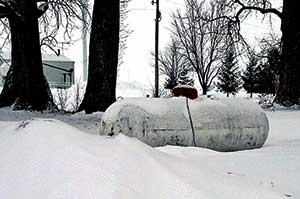Marketers avoid year-ago scenario with ample supply, lower demand
Detailed, robust preparations also play part in overcoming onslaughts of nasty weather.

Some regions of the country experienced the coldest temperatures on record, but high inventories and marketer preparation made for a relatively smooth heating season. Photo: Purdue Agricultural Communication photo/Steven Cain
Although you might have a slightly differing viewpoint if you struggled with sporadic supply shortages, the overall consensus regarding this year’s heating season is being described as “smooth and steady.”
Some retailers experienced some rough and harried patches, of course, with weather conditions dumping big snow and posting record-busting cold temperatures. The Boston area had its deepest snowfall total ever, and numerous communities bottomed out with the lowest thermometer readings since they began keeping track in the 1800s.
On balance, however, the winter was comparatively moderate and propane was in good supply, especially when taking the challenges of 2013-14 into account.
The industry did well in planning ahead.
“The record low temperatures came very late in the winter,” says economist Tancred Lidderdale at the Energy Information Administration (EIA). “This winter on the whole was certainly milder than last winter … and inventories were much higher than last winter.”
This past fall reaped a record-setting harvest, yet LP gas crop drying demand was less fruitful than the previous season due to less rain.
“The cold hit early in the winter last year,” adds Lidderdale, describing a situation that was avoided this season as the cold was delayed.
“There was a large corn harvest, but it wasn’t as wet as last fall,” Lidderdale says. “We started the winter with higher inventories, and the higher inventories helped ease the pain we experienced last year.”
Consultant Marty Lerum, a principal at Propane Resources, says it turned out to be a good season for propane.
“A higher percentage of retailers nationwide locked in their margins compared to last year,” he says. “Twice as much fixed-price product was purchased this year compared to last winter.”
And the preplanning made for a smoother ride.
“They lined up their railcars last year in the March-April timeframe,” Lerum says. “People went out and paid for insurance this winter by committing to tank cars and it paid off.”
Arrangements were also made ahead of time to buy propane off the high seas, even if those diversified supply options were more expensive.
Despite the higher costs involved, many marketers decided that “I’m going to cover my demands” in advance of the heating season.
“If you’re cheap and you don’t want insurance, be prepared to have your house burn down every five years,” Lerum says.
“They knew that they were going to get their gallons; the propane was there,” he says. “A lot of retailers locked in their prices, more than normal – which is natural after they got burned last year.”
Cinch Munson, director of agriculture business development at the Propane Education & Research Council (PERC), says it saw a lot of consumers fill early. He credits the $5.5-million “Be Prepared” awareness campaign with assisting in getting the word out.
The readiness of the retailers was apparent as well, according to Global Gas President D.D. Alexander, and spiking prices were avoided.
“They took the advice from the National Propane Gas Association (NPGA) and got their supply early. When it gets too late, they miss the party,” she says. “It was a smooth and steady year.”
Apples and oranges
When comparing the winter of 2014-15 to that of 2013-14, “it really is apples and oranges,” says Propane Concepts’ George Koloroutis, chairman of NPGA’s Propane Supply and Logistics Committee.
He addresses the advantages of being ready for whatever the winter of 2015-16 will bring: “I think the supplier sees their customers – propane marketers – in two categories. There are some who communicate well and prepare and some who don’t. I’m hopeful that the ones who don’t are the minority now,” he says.
“As a supplier, you really value your customers who communicate well, are very prepared and give you good demand-forecasting models. You like those customers. The ones who run to you in panic at the last minute are tougher to serve,” Koloroutis adds. “It’s no different for the propane marketer in how they deal with their customers. They have some customers who are great communicators and some who aren’t.”
“Don’t be complacent,” Alexander agrees. “Next year may not be like this year,” and now is the time to start covering supply needs. “They shouldn’t go back to their old ways just because of one year. They always remember what happened ‘last year’ to dictate their supply decisions for the coming winter, and that can be a mistake.”
“You have to be a good marketer and sign people up for budget plans, and you have to have the accounting software to keep track of it,” Lerum says. “That allows you to go fill up their tanks in the summer and fall before it gets cold.”
Rush hour on the rails
Weather-related transportation woes made for some anxious tight supply moments in the Northeast, putting pressures on dedicated personnel driving long distances and working long hours.
“The supply issues were short term and they were primarily logistics issues. There was plenty of gas to be had; it was just a logistics issue of getting the gas to where it should be,” explains Norm Guerette, chairman of the board at the Propane Gas Association of New England (PGANE) and general manager at the Dead River Co.
“There was some level of frustrations in getting railcars to our facilities. They just weren’t getting delivered fast enough to our membership,” he says, citing the impact of deep snow, as workers were forced to clear rail yards and switches before the rolling stock could get moving.
“There are a lot more crude oil tankers on the railroads,” Lerum adds. “The tracks were crowded and it takes more time to get there. It’s like rush hour all the time in winter.”
Prior to the heating season, PGANE President Joe Rose made arrangements for biweekly phone calls among governmental officials “to keep them up to speed” with the supply status and hours-of-service (HOS) requests.
“The states appreciate the proactive approach,” Rose says. “We had a meteorologist on retainer, and that was a very effective tool. We were able to give them good data. They wanted facts, and that’s what we gave them.”
The travails of last winter “certainly didn’t hurt” in securing HOS approvals, he adds.
“Our folks could work longer days to make their deliveries,” Guerette says. “We delivered into the evening to get a jump-start on the next day.”
Treacherous traffic conditions were common and tanks were frequently buried in snow, resulting in extra efforts when working with the hoses.
“With all the storms we had, we ended up with some delayed starts. We had some days where we had to call our people in off the road early because it was getting dangerous,” Guerette recalls. “Saturdays and Sundays became regular delivery days to make it up.”
In several cases, Paraco Gas put team members in nearby hotels so they could make it to work, says Mike DeVoe, executive vice president at the New York-based company. And occasionally, managers made the rounds in four-wheel-drive vehicles, picking up snowbound employees to accomplish a safe commute.
Slipping and sliding
John Jessup, executive director of the North Carolina Propane Gas Association (NCPGA), says its members were prepared this year.
“A lot of them had a supply plan, so they had plenty of gas,” he adds.
Calculations began last spring and continued through summer and fall.
“They had more robust and detailed plans instead of just picking up the phone and ordering more gas,” he says.
February was one of the best months some NCPGA members have ever experienced, according to Jessup.
“We had a lot of cold weather, ice and snow that hung around – which it usually doesn’t,” he says.
Bobtail crews worked overtime to overcome delays.
“They had to put two people on a truck; it’s hard to deliver propane when you’re slipping and sliding. There are only so many deliveries you can make in a day,” he says.
Throughout the South, “it was a pretty smooth deal” as pipeline spigots were augmented by adequate transport availability, unlike last year.
“The only issues they had was when there was snow and ice,” Lerum says. “Icy roads were slowing down deliveries to your customers and it slowed down deliveries to your facilities.”
Hitting the fan
“This was a pretty smooth year,” says Purdue Extension Disaster Specialist Steve Cain in Indiana. “It was certainly better than last year, and it was the coldest weather on record in our area.”
Massive conservation efforts have been taking place, Cain recognizes. Numerous homeowners have been upgrading insulation and installing new windows along with blocking off unused rooms, bundling up and lowering thermostats, leading to static propane consumption rates.
Consumption amid a consistently cold February for McMahan’s Bottle Gas in Ohio was running ahead of 2013-14 as spring struggled to take hold.
“I wouldn’t say we were running out, but we were lower than I wanted to be. Fortunately it was towards the end of winter instead of at the beginning like last year,” says owner Joe Buschur. “When it hit the fan, everyone had the same problem of waiting in lines.”
Transports traveled to Minnesota and New Hampshire, and waits of more than 12 hours awaited suppliers filling up in Catlettsburg, Ky., and Huntington, Ind.
Due to waiting-in-line fees of 10 cents to 12 cents a gallon, “we paid more for our gas than we were expecting,” Buschur says.
The biggest issue for marketers in Kansas this winter centered on a price decline, according to Greg Noll, executive vice president at the Propane Marketers Association of Kansas.
“We promoted and preached and we begged people to get ready,” he says, referring to lining up adequate supplies and selling budget plans. “Then the landscape changed for contracted customers,” as the per-gallon pricing went down.
Among customers who actually track the ebb and flow of propane cost figures, marketing contracts for next winter might be more difficult, but it’s still a good deal, Noll says.
“It’s an insurance policy that the price will not be higher than what they’ve agreed to pay,” he adds.
Much of the West was blanketed with record warm temperatures as long-term drought conditions continued unabated.
Supply held steady in the Northwest, and “we never really had a winter this year,” says Robert Jacobs at Delta Liquid Energy, based in Paso Robles, Calif. “There was not a lot of residential gas sold this year.”
The propane heaters utilized by farmers to take the chill off their crops saw reduced usage.
“There was very little with frost protection – lower than usual,” Jacobs says.
“Our company has focused on being very diversified for many years,” he says, noting the benefits of serving the autogas and irrigation markets. “While heating gas has suffered, overall volumes have not.”
The irrigation market in California is strong, providing additional opportunities for propane, says Alexander at Global Gas.
“We’re seeing demand for these engines continuing to grow,” Munson says. Constructed from the ground up to operate on LP gas, “they cost less to buy and less to run. We’re seeing a lot of people looking at this new generation of propane engines.”
SPECIAL REPORT FROM LP GAS
The propane industry experienced one of the most challenging winter heating seasons on record in 2013-14. In preparation for future winters amid a changing energy environment, LP Gas is examining the issues that led to what some called a crisis supply situation. We are reaching out to all segments of the industry to explore our past and future, bringing attention to key subjects, initiating industry dialogue and providing necessary education to our readers.


















